Cape Cod, with its picturesque coastline and abundant marine life, is a seafood lover’s paradise. One delicacy that stands out among the coastal offerings is the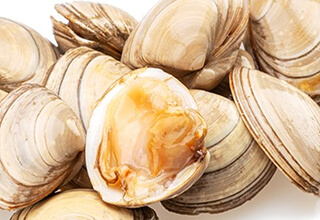 diverse array of clams found in the region. From the briny shores of Cape Cod Bay to the sandy flats of Wellfleet, these bivalve mollusks offer a culinary adventure like no other.
diverse array of clams found in the region. From the briny shores of Cape Cod Bay to the sandy flats of Wellfleet, these bivalve mollusks offer a culinary adventure like no other.
If you would like to tantalize your taste buds with the fresh seafood delicacy of clams please continue reading. In this blog post, we will delve into the different types of clams found on Cape Cod, Martha’s Vineyard, and Nantucket to explore their various uses, discuss preparation requirements, and shed light on the art of collecting these treasures from the sea.
Below we will outline the types of clams found on Cape Cod:
1. Quahogs
As the first day of summer approaches, Cape Cod gets ready to celebrate the quahog with the annual Quahog Day!
The quahog is the largest and one of the most iconic clams found on Cape Cod. Often referred to as a hard-shell clam, the quahog is cherished for its sweet and briny flavor. These clams can range in size from one to three inches in diameter, with some reaching up to six inches.
Quahogs are versatile and can be used in a variety of dishes, including clam chowder, stuffed clams, or simply steamed and served with melted butter. When collecting quahogs, it’s important to obtain a permit, as they are regulated to maintain sustainability.
2. Razor Clams
Razor clams, also known as Atlantic jackknife clams, are prized for their unique, elongated shape and sweet, delicate flavor. These clams are found burrowed in the sandy beaches of Cape Cod and collecting them requires patience and skill. When it comes to preparation, razor clams are typically cleaned, shucked, and either steamed, fried, or grilled. Their meat can be used in various recipes, such as soups, stews, or pasta dishes, where their flavor and texture can shine.
3. Cherrystone or Littlenecks
Cherrystone clams, also known as littlenecks, are a type of hard-shell clam that 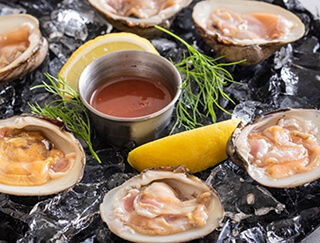 can be found along the shores of Cape Cod. These clams are named after Cherrystone Creek in Virginia, where they were first commercially harvested. Cherrystone clams are prized for their sweet, briny flavor and tender meat. They are smaller in size compared to quahogs, typically measuring only around two to three inches in diameter.
can be found along the shores of Cape Cod. These clams are named after Cherrystone Creek in Virginia, where they were first commercially harvested. Cherrystone clams are prized for their sweet, briny flavor and tender meat. They are smaller in size compared to quahogs, typically measuring only around two to three inches in diameter.
The cherrystone clam is often enjoyed raw on the half-shell, steamed, or used in various cooked preparations such as clam sauces, pasta dishes, or seafood stews. Their versatility and delightful taste make them a favorite among seafood lovers and a delightful addition to Cape Cod’s culinary scene.
4. Cockle Clams
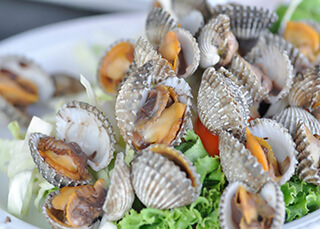 Cockle clams are a fascinating type of bivalve mollusk found in the coastal areas of Cape Cod. These small, heart-shaped clams are known for their distinctive ridged shells and delicate flavor. Cockle clams are often found buried in the sand or mud flats along the shoreline. They have a slightly sweet and nutty taste, which makes them a delightful addition to seafood dishes.
Cockle clams are a fascinating type of bivalve mollusk found in the coastal areas of Cape Cod. These small, heart-shaped clams are known for their distinctive ridged shells and delicate flavor. Cockle clams are often found buried in the sand or mud flats along the shoreline. They have a slightly sweet and nutty taste, which makes them a delightful addition to seafood dishes.
While not as widely recognized as some other clam varieties, cockle clams are highly versatile and can be used in a variety of culinary preparations. They can be steamed, grilled, sautéed, or even added to soups and stews to impart their unique flavor. With their beautiful shells and delectable taste, cockle clams offer a culinary adventure for those seeking to explore the diverse clams found on Cape Cod.
5. Soft-Shelled Clams (Ipswich Clams)
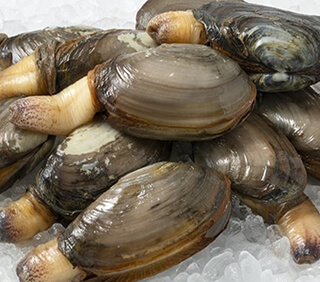 Soft-shelled clams, also known as Ipswich clams, are another clam variety found along the shores of Cape Cod. These clams have thin, brittle shells that are easily broken. Steamers are a popular choice among clam enthusiasts. These soft-shell clams are known for their tender texture and rich, buttery flavor.
Soft-shelled clams, also known as Ipswich clams, are another clam variety found along the shores of Cape Cod. These clams have thin, brittle shells that are easily broken. Steamers are a popular choice among clam enthusiasts. These soft-shell clams are known for their tender texture and rich, buttery flavor.
Steamers are commonly steamed in a pot with water and sometimes garlic or beer, until their shells open, indicating they are cooked and ready to be enjoyed. They are often served with the cooking liquid as a dipping broth. Steamers can also be used in clam bakes, fried clam dishes or added to pasta dishes to elevate their flavor.
6. Mahogany Clams
Mahogany clams, also referred to as mahoganies or Atlantic surf clams, are larger clams that can be found in the sandy shores and shallow waters of Cape Cod. These clams are known for their meaty texture and distinct, sweet flavor. They have a rich, dark shell with unique patterns. Mahogany clams are commonly used in clam strips, chowders, and other seafood recipes where their robust flavor can stand out.
7. Ponderous Ark Clams
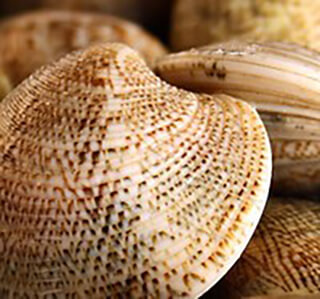 Ponderous ark clams, scientifically known as Anadara ponderosa, are large bivalve mollusks found in the coastal areas of Cape Cod. These clams have thick shells with distinct ridges and can reach impressive sizes. Ponderous ark clams have a firm, meaty texture, and a mildly sweet flavor. They are often used in clam bakes or cooked in various preparations like stews, soups, or pasta dishes, where their substantial size and taste can be appreciated.
Ponderous ark clams, scientifically known as Anadara ponderosa, are large bivalve mollusks found in the coastal areas of Cape Cod. These clams have thick shells with distinct ridges and can reach impressive sizes. Ponderous ark clams have a firm, meaty texture, and a mildly sweet flavor. They are often used in clam bakes or cooked in various preparations like stews, soups, or pasta dishes, where their substantial size and taste can be appreciated.
What You Need to Know About Collecting Clams Found on Cape Cod
Collecting the clams found on Cape Cod is a fun activity for young and old alike. Many areas have public clamming grounds, but it is essential to research local regulations and obtain the necessary permits before venturing out.
Low tide is the best time to go clamming, as the receding water reveals the clam beds. A clam rake or a clamming fork is commonly used to gently dig into the sand and unearth the clams.
Clam Preparations
Okay, you have gathered the clams, and now it’s time to focus on preparations.
Preparing clams for eating can vary depending on the specific recipe or dish you plan to make.
Here is a general guide on how to prepare clams found on Cape Cod:
Cleaning and Inspection:
- Rinse the clams under cold water to remove any dirt, sand, or debris.
- Inspect each clam and discard any that have cracked or open shells. If a clam is open, give it a gentle tap; if it doesn’t close, it should be discarded as well.
Purging (optional):
- Some people prefer to purge clams to remove any sand or grit inside them. To do this, place the clams in a bowl of saltwater or lightly salted water (about 1/4 cup of salt per gallon of water) for 30 minutes to 1 hour. This helps the clams expel any sand or impurities they may have.
Shucking (optional):
- Shucking refers to the process of opening the clams’ shells to remove the meat. This step is necessary for certain recipes like clam chowder, pasta dishes, or raw preparations like clam ceviche or clams on the half-shell.
- To shuck clams, you’ll need a clam knife or a thin, sturdy knife with a sharp blade.
- Hold the clam firmly in one hand and insert the tip of the knife between the shells near the hinge.
- Gently twist and wiggle the knife to separate the shells, being cautious not to damage the meat.
- Once the shell is open, slide the knife along the inside of the top shell to release the muscle that attaches the clam to the shell.
- Remove the top shell, and then slide the knife under the clam meat to detach it from the bottom shell.
- Rinse the clam meat to remove any residual sand or shell fragments.
Cooking Methods:
 Clams found on Cape Cod can be cooked using various methods, depending on your preference and the recipe you’re following. Some popular cooking methods include:
Clams found on Cape Cod can be cooked using various methods, depending on your preference and the recipe you’re following. Some popular cooking methods include:- Steaming: Place clams in a pot with a small amount of liquid (such as water, wine, or broth) and cover. Steam the clams over medium-high heat until the shells open, usually within 5-10 minutes.
- Boiling: Submerge clams in a pot of boiling water and cook until the shells open, about three to five minutes.
- Grilling: Brush the shucked clams with oil or butter and grill them over medium heat for two to three minutes until cooked and slightly charred.
- Frying: Dredge shucked clams in a mixture of flour, cornmeal, or breadcrumbs, and shallow fry them in hot oil until golden brown and crispy.
Remember, cooking times may vary based on the size of the clams and the specific recipe you’re using. It’s important to make sure that the clams are fully cooked.
Now that you have prepared your clams, you can use them in a wide range of delicious recipes, such as clam chowder, clam linguine, clam fritters. You can also simply enjoy the clams on the half-shell with a squeeze of lemon. The possibilities are endless, and the taste of fresh, properly prepared clams is truly a culinary delight.
Conclusion
The clams found on Cape Cod are a testament to the region’s rich culinary heritage. Enjoy the bountiful harvest! Whether it’s the robust quahogs, tender steamers, elusive razor clams, or the beloved Wellfleet oysters, each variety offers a unique how do you prepare clams to eat.
After your feast of clams, learn about recylcling shells on Cape Cod.

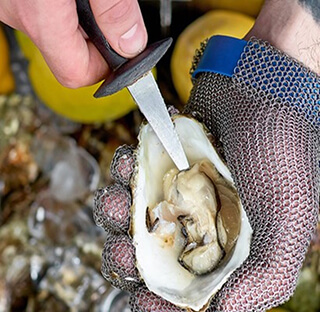 Clams found on Cape Cod can be cooked using various methods, depending on your preference and the recipe you’re following. Some popular cooking methods include:
Clams found on Cape Cod can be cooked using various methods, depending on your preference and the recipe you’re following. Some popular cooking methods include:










